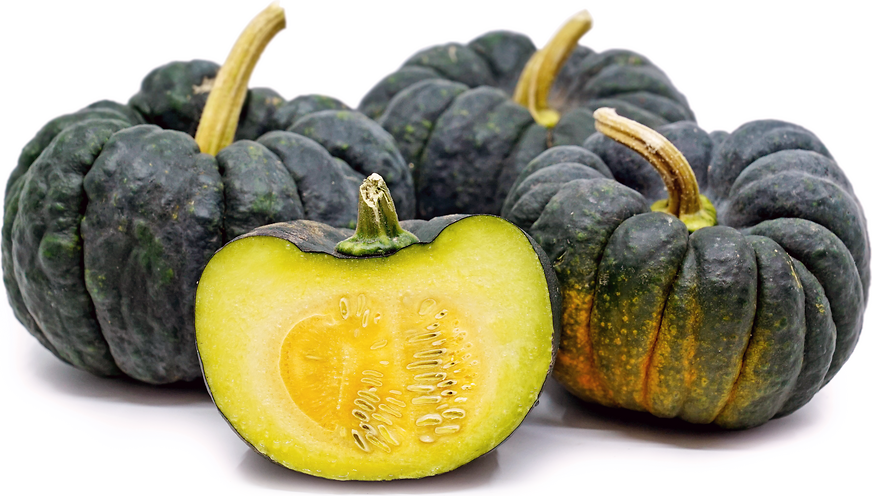


Yokohama Squash
Estimated Inventory, lb : 0
Description/Taste
Yokohama squash is round and flattened with a large depression at the stem end. Its dark green, bumpy skin is deeply ribbed with a silvery bloom, and will turn tan, then orange if left on the vine. It’s 20 centimeters in diameter and 10 centimeters high, and weighs between 4 and 6 pounds. The flesh is dark orange and fine-grained, offering a smooth texture, and has a small seed cavity. It offers a rich floral aroma and a flavor profile reminiscent of sapote and mango with hints of spice.
Seasons/Availability
Yokohama squash is available in the fall and winter months.
Current Facts
Yokohama squash is a rare heirloom variety with a history that dates to a treaty between the United States and Japan that opened select ports for commerce and trade. The winter squash or pumpkin, botanically classified as Cucurbita moschata, was named for one of the first ports in Japan to allow foreign travelers. It is known for its resistance to disease and pests and its long shelf-life.
Nutritional Value
Yokohama squash is high in vitamins A and beta-carotene which benefit eye health and are rich in antioxidants. It is a good source of dietary fiber, vitamin C, potassium, and manganese, and contains omega-3 fatty acids, B-complex vitamins, and copper. Yokohama squash seeds are high in protein and contain traces of essential minerals.
Applications
Yokohama squash is ideal for grilling, baking, roasting, frying or adding to soups. Sautee wedges in oil or ghee or remove the rind and batter with tempura and fry. Add pieces of diced Yokohama squash to Japanese stew or hot pot. Puree the flesh for stuffing dumplings or ravioli. Use Yokohama squash in recipes calling for butternut or other winter squashes. The seeds can be eaten raw, toasted or pressed for oil. Yokohama squash will store in a cool, dry place for several months without loss of flavor or quality. Freeze any unused pieces for up to 3 months.
Ethnic/Cultural Info
Yokohama squash was cultivated for several hundred years in Japan before being introduced to the United States in the early 1860s. During the 16th century, Portuguese explorers brought Cucurbita moschata seeds to Japan from South America. There, Japanese farmers developed the Yokohama variety through years of strict horticultural practices. Today, there are several different varieties that make up a distinctive “Yokohama group”. One variety, chirimen, is thought to be a descendent of the Yokohama squash brought to the United States.
Geography/History
Yokohama squash are native to Japan and were introduced to the United States from Yokohama in 1862. James Hogg, a horticulturalist in Yorkville, New York, received seeds for the Japanese squash from his brother Thomas, who settled in Yokohama after the 1858 signing of the Harris Treaty. He grew the vegetables, named them for their city they came from, and declared them better than the widely planted hubbard squash. Unfortunately, Yokohama squash did not surpass the hubbard in popularity and disappeared from gardening and seed catalogs after a few decades. The heirloom revival resurrected many older varieties, including the Yokohama squash. The rare variety may be spotted at local farmer’s markets, at small farms, or in backyard gardens.




